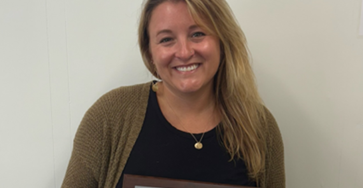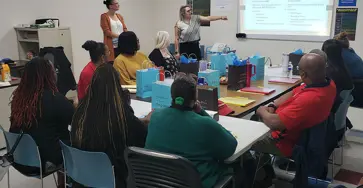
New Castle’s second American Legion post, Post 830, has been chartered since 2015.
The 38 members hold meetings, do community service projects and help other veterans apply for the benefits they earned through military service.
Flags of the various military services and banners remembering prisoners of war and those missing in action line the post hallway.
The only difference between Post 830 and the other veteran organizations in Henry County is that this one is behind the electric and concertina wired fences of New Castle Correctional Facility.
“We may be incarcerated, but we’re still veterans,” said Post Commander Ben Wash, who served in the U.S. Navy from 1989-1990. “We’re proud to have answered our country’s call to arms, and we’re still able and willing to try to make a difference.”
The New Castle Correctional Facility has a program designed specifically for veterans. It is called HUMV, which stands for H-Unit Military Veterans. A four-wheel drive light military truck is also called “humvee” because it has a similar acronym.
The men in HUMV organized Post 830 in 2013. They received a temporary charter and started holding regular business.
The Adjutant Commander of the American Legion Department of Indiana officially chartered the post Oct. 22, 2015.
HUMV also has an American Veterans (AMVETS) post, which boasts more than 100 members.
“We are held to a higher standard than the rest of the inmates here,” Wash said.
HUMV is the largest program for veterans in the Indiana Department of Corrections.
Wash said the veterans programs in New Castle Correctional Facility help boost morale of the men in H-Unit.
“It keeps us busy and keeps us out of trouble,” he said.
HUMV Unit Manager Thelma Nornes said H-Unit has the lowest recidivism rate for the correctional facility. That means fewer men from H-Unit are breaking the law again after getting out than in any other part of the New Castle prison.
“They’ve got it in themselves,” Nornes said. “They are more than just convicted felons. They are people.”
The New Castle Correctional Facility also works with local veterans services once H-Unit vets go home as a way to help them reintegrate with society.
American Legion Post 830 helps get the ball rolling before men even finish their sentences.
Post 830 Service Officer John Collier, an Army retiree, has helped facilitate $1 million in pending disability claims for HUMV inmates since October.
Collier helps them apply for disability, pensions and dependent benefits, if needed. He has also help some of the guys upgraded their discharge status, which can give them access to more benefits.
Collier has been a Legionnaire for 20 years. He has contacts with Legion posts all around the state that help guys transition when they get home.
Wash said they can’t personally follow up on the success of the program once guys leave the prison because of rules forbidding contact.
Instead, Post 830 looks at the low recidivism rate and high success rate of benefit applications as indicators of success.
The men spend a lot of time crafting scale models of famous military vehicles. They donate those models to other posts and military facilities to help preserve history and fund programs.
Air Force vet and Post 830 Project Manager Steven Wilson said the projects challenge post members to think outside the box. This can also help them learn skills or ways of thinking that they didn’t have before ending up in prison, Wilson said.
Men from Post 830 created scale models of the USS Indianapolis BB-1 and BB-58 ships that they will donate to the USS Indianapolis Commissioning Committee.
The turrets on the models move and the camouflage matches photos exactly.
“The attention to detail recognizes the men who served on the ships,” Wilson said.
They also donated a scale windmill and memorial flag to the AMVETS as auction items. Wilson hopes that money will help fund an Honor Flight to Washington, D.C., for an older veteran.
The Legionnaires also make wooden “challenge coins” for veterans courts around Indiana. Challenge coins are special tokens that the different branches of the military use to recognize a job well done.
“One of the things we prescribe to is not living by that jailhouse or prison mentality,” said Army veteran David Jones, representing HUMV Pod 3.
The programs in H-Unit don’t just benefit the veterans. Non-vets, like James Boyd, take part in the projects, too. Boyd said the veterans have taught him a sense of family and given him examples of how to change his thinking.
HUMV also has classes that teach the inmates life skills that will help them once they get out of prison. A few of the classes are Thinking for a Change, Inside/Outside Dad, anger management and Financial Peace.
“We are trying to better ourselves, help each other. Try to make ourselves better men for when we leave,” said Rich Lowe of Pod 1.
Nornes said everything in H-Unit adds up to breaking the cycle of the criminal mentality.
“You are more than a felon,” Nornes told the men. “You are a person.”

